

How To Make A Rainbow – Simple Science Experiments
Making a rainbow is a fun and educational science experiment that can be easily done at home or in the classroom.
It involves using a light source, such as sunlight or a flashlight, and a medium to separate the light into its component colors.
The result is a beautiful display of the colors of the rainbow, which can be used to teach about the nature of light and color.
This experiment is an engaging way to introduce children to the basics of optics and the physics of light.
How Are Rainbows Formed?
Sunlight or white light is a mixture of all the rainbow colors. The different rainbow colors are essentially mixed together to result in a white color.
You may wonder why when you mix all the different colors of paint together result in black instead of light. That is because light mixing is additive while pigment mixing is subtractive.
When light passes from one medium to another medium of a different density (e.g. from air to water ), the light bends. This is known as refraction of light 1 (More light experiments ).
How much a light is refracted depends on the wavelength of the light. The shorter the wavelength, the more it bends. Because lights of different colors have different wavelengths , each color is refracted by different amounts.
Therefore, white light is split up after passing from air to water and the individual colors become visible. This dispersion of light allows us to see the spectrum of colors that form a rainbow 2 .

In nature, a rainbow is formed when sunlight is refracted on entering a droplet of water, reflected inside the back of the droplet and finally refracted again on leaving the droplet.

Seeing A Rainbow
To see a rainbow caused by sunlight, the sunlight needs to come from behind us because rainbows only appear in the part of the sky directly opposite the sun.
Red has the longest wavelength among the visible colors. So it tends to bend the least and the angle between the incident light and our line of sight for red is approximate 42 degrees. As a result, red appears on the top of the rainbow
Violet has the shortest wavelength. It tends to bend the most. To see violet, the angle between the incident light and our line of sight is roughly 40. So violet appears at the bottom of the rainbow.

Why Are Rainbows Arched?
Rainbows are not two dimensional . A rainbow is seen at an angle that is between 40-42 degrees from the incident sunlight . So all the water drops that produce each color in the rainbow lie on a three dimensional cone . Our eyes are at the tip of the cone.
That is why rainbows are arched. The circular shape below the ground is invisible.

Rainbow Experiment
Now are you ready to make some rainbows? Here are 3 easy ways to make your own rainbows at home.
Warning: Adult supervision is vital in experiments involving sunlight. Do not look directly at the sun or at the reflection of sun in a mirror.

1. Rainbow Prism
One of the easiest and most visually stunning ways to see an artificial rainbow is by using a prism. Creating rainbows using a prism is really fun.
- strong sunlight
- glass prism
- white cardboard / paper (optional)
- adult supervision
Instructions
- Place a piece of white paper on the ground under the sunlight.
- Put the prism on or above the paper.

Recommended Products
As an Amazon Associate, I earn from qualifying purchases.

Did you try this project?
Follow us on Pinterest and share a photo!

2. Rainbow On The Wall
No prism? No problem. Using a small mirror and a glass, you can make a beautiful rainbow on the wall.
- a clear glass
- small mirror
- Fill the glass with water.

- Position the glass so that sunlight shines directly at the mirror. You may have to shift the mirror to find the right angle.
- Look for a reflection on the wall. It would be easier to see if the room is dark.

3. Make A Rainbow Using Flashlight
You can still make a rainbow without natural light. Try this experiment using a whitelight flashlight.
- clear glass
- flashlight that emits strong focused white light . Flashlights that emit only yellowish light won’t work. Flashlights that don’t emit focused light also won’t work. Look for one with parabolic reflecting mirrors inside to focus the light, or one with a strong LED light.
- 2 pieces of white cardboard
- Cut a narrow rectangle in the middle of one piece of paper.

- Place the other piece of paper on the floor on the other side of the glass to catch the rainbow.

- Start from the glass and slowly move the flashlight farther and farther from the glass.

More Making a Rainbow Experiments
If you’re a rainbow enthusiast, want more rainbow experiments, or wonders what makes a rainbow, here are a few fun science projects for you.
- Rainbow Water
- Rainbow Walking Water
- Crystal Rainbow
Learn More About Rainbows

Have Fun With Rainbows

- 1. Jiang W, Chen RT, Lu X. Theory of light refraction at the surface of a photonic crystal. Phys Rev B . June 2005. doi: 10.1103/physrevb.71.245115
- 2. Whitaker RJ. Physics of the Rainbow. The Physics Teacher . May 1974:283-286. doi: 10.1119/1.2350374
Last update on 2024-12-04 / Affiliate links / Images from Amazon Product Advertising API
Similar Posts

Lava Lamp Experiment
Did you know that oil and water are not the same density? That is why oil and water don’t mix….

Why Is The Sky Blue? Simple Science (Video)
The Blue Sky On a clear day, the sky is nothing more than the air in the atmosphere. The air…

Build A Simple Electric Circuit
Electricity is all around us. We use electricity everywhere in our daily lives. We use it to light our rooms,…

Floating Rice Experiment
Friction Experiment This experiment is about friction. Friction allows us to walk on the road instead of sliding on it….

Bread Dough Rising Experiment
Science is all around us. Oftentimes, we apply the principles of physics, chemistry or biology without even knowing. We can…

Light Refraction Experiments
Refraction Of Light Have you ever noticed if you look through a glass of water, the image behind the glass…
Preschool Inspirations
Preschool Activities and Learning
Super Fun Rainbow Science Activities Just For Kids
March 8, 2018 by Editor Leave a Comment
Rainbows are one of my favorite parts of Spring. It usually means that the sun is shining and I’m always happy with that. Even though it usually means it is raining as well, but I’ll take the sunshine when I can get it! Incorporating rainbows in science activities is not only fun but super easy. These Rainbow Science activities are perfect for the classroom or at home. Most of them don’t require much prep but all of them will have kids smiling in science giddiness!
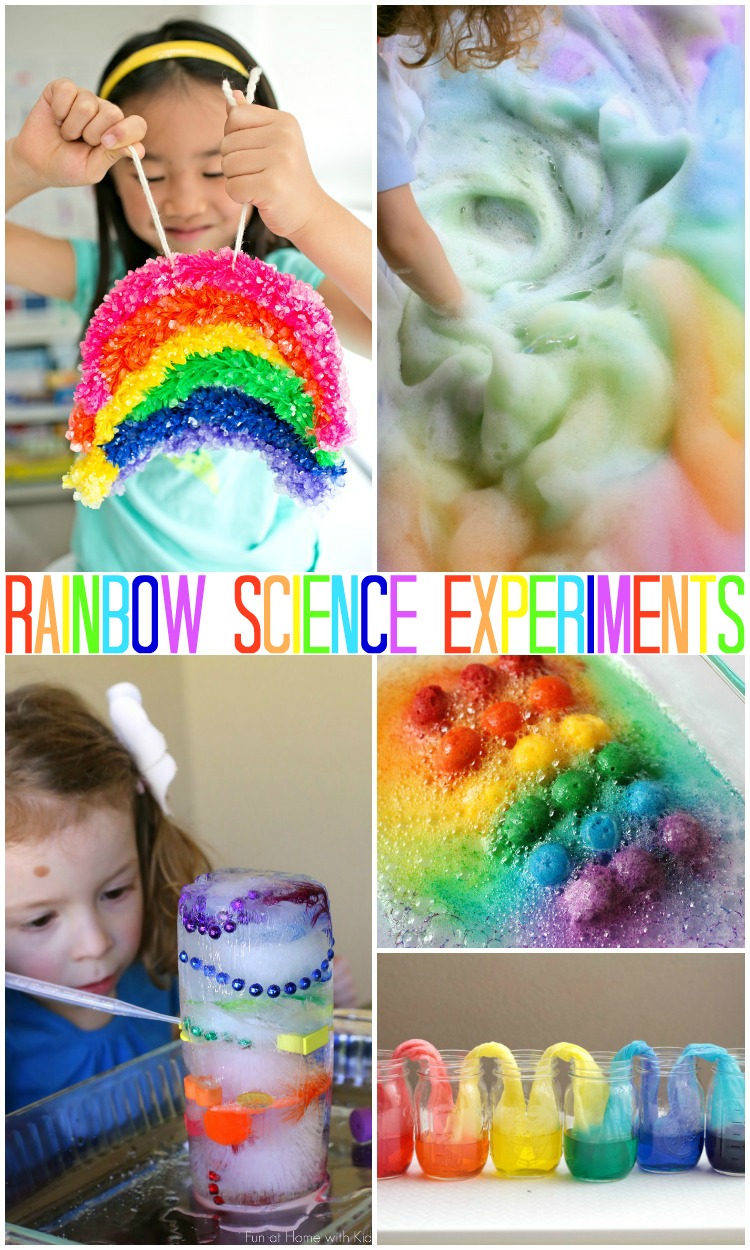
Rainbow Science Activities
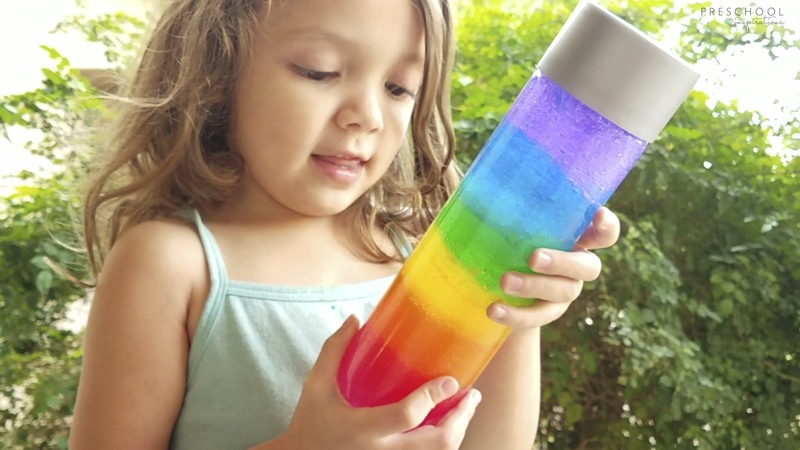
Finally a rainbow discovery bottle that the colors don’t run together! I’ve been trying and experimenting for a while now and finally figured it out! It’s not quite liquid and not solid either. It’s a perfect combination of awesomeness! Want to make one of your own? The full tutorial is here .

Get the best learning activities for 3-5 year olds at your fingertips
See inside the book!

We’ve all done baking soda and vinegar experiments, right? This Baking Soda & Vinegar Reaction though is the most colorful I have seen and I can just imagine how excited kids will be to see the rainbow foam explosions!
Oil and water make science experiments super easy and fun. This Rainbow Jar is extra fun, not only because of the colors, but it is mesmerizing how the colors stack up on top of each other!
These candies are fun to eat but even more fun to play with. This Skittle Rainbow is beyond the best candy experiment I have seen. I could watch this for hours!
Chromatography is a fun way to incorporate science and art together. These Rainbow Filters are fun to create but then also fun to create with!
Did you know that dish soap can do magical things? This Magic Rainbow Milk is purely magical. The colors move seemingly on their own, but are they moving on their own?
When science and sensory connect, it is always a great activity. This Scented Rainbow Science is perfect for sensory seekers! Plus, adding the scent is probably the easiest part!
This Exploding Rainbow is exciting to create and even more exciting to watch. Kids will enjoy these hands-on mini ‘explosion’. Even if we know it is only a simple reaction, kids will love to pretend their rainbows are exploding!
There is something incredibly fun about swirling your hand around in a big bowl of soap foam! This Rainbow Foam Bubbles activity is not only a fun sensory activity but also helps teach about color mixing as well.
Rainbows are pretty but Giant Crystal Rainbows are even more beautiful. Kids will enjoy watching the crystals grow on their rainbow! It may take a day but the magic of the crystallizing process will not be lost!
This Fizzy Rainbow Slush takes baking soda and vinegar to a whole new level. Plus if it is hot outside, you can place this slush in the fridge for a while and the kids can play in cold slush!
This Rainbow Sugar Water Density shows that adding sugar to colored water can help the colors separate instead of mixing together, which is excellent for younger children. This is also a fantastic way to introduce or teach about density for older children!
Pumpkin Seeds are not only for fall. These Pumpkin Seed Discovery Bottles are rainbow all the way and is a go-to activity for any time of the year!
Do your kids love playing with ice? And melting ice with hot water? This Rainbow Ice Tower is filled with colorful items frozen into a tower and the excitement is getting them out! I can see kids being occupied for quite a while with this one!
Science these days is not complete without slime and this Rainbow Slime is a MUST. It is absolutely beautiful how the colors connect but don’t mold together. This recipe is anything but icky!
Just like with the skittles experiment above, this M&M Rainbows is mesmerizing! It is incredible how candy can taste AND look so beautiful!
I love how this Erupting Rainbow comes out of little test tubes. Kids will feel like real scientists even though this experiment is incredibly simple!
This twisted rainbow is sparkly in all the right ways. Kids will enjoy creating this Salt Crystal Rainbow and displaying it all Spring long!
Sometimes science is simple and other times it is purely magical. The art that this Rainbow Paper experiment can make is fantastic! This would be beautiful to put on the front of cards or notes!
This Walking Rainbow experiment has me screaming HOW in my head. I want to explore this experiment because it just looks unreal. Science is so fascinating and this is one of those worldly mysteries that would be fun to solve!
This Ice & Salt Rainbow actually creates craters. As pretty as it is, it can do crazy things when combined together. This would be a fun science activity to add to a small world play with dinosaurs or superheroes!
This Rainbow Colored Ants activity is purely fascinating. This would be a fun lesson to teach for either a bug unit or even Spring. Super interesting!
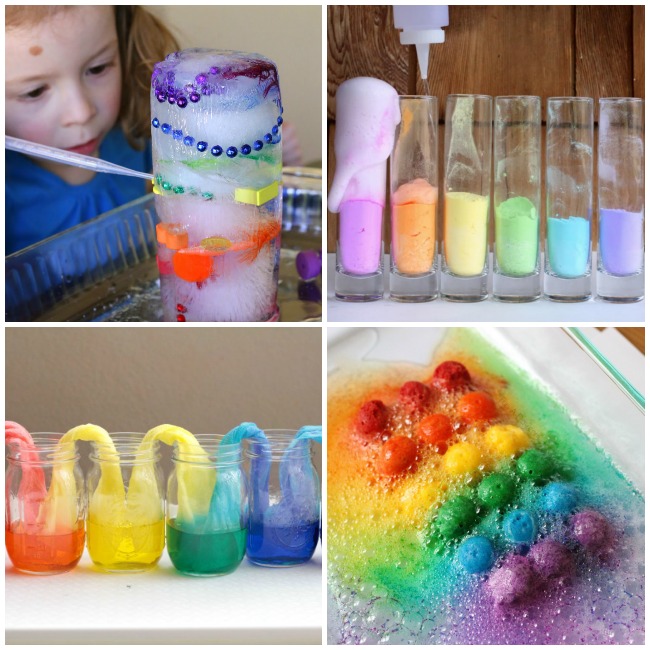
Rainbows are beautiful in the sky and can create magic in the real world. These Rainbow Science activities are a close second to being magical in the real world. Whether you are teaching a spring unit, teaching about the weather or just wanting some fun colorful activities – these science activities are sure to please!
- Recent Posts
- November Preschool Themes You’re Going to Love! - October 12, 2024
- Valentine’s Day Letter Formation Mats - February 4, 2024
- January Preschool Themes You’re Going to Love! - January 1, 2024
Leave a Reply Cancel reply
Your email address will not be published. Required fields are marked *
Notify me of follow-up comments by email.
Notify me of new posts by email.
This site uses Akismet to reduce spam. Learn how your comment data is processed .
- Activities for Kids
6 Incredibly Easy Rainbow Science Experiments
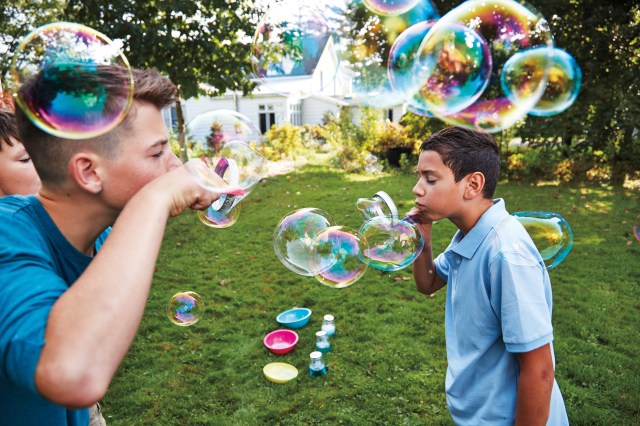
If you can’t find one, make one of your own, right in your kitchen, porch, or stoop
No rainbow in the sky today? No problem. Just pick one (or all) of these easy kid-friendly science experiments with your rainbow-making know-how. From reflection (mirror) to refraction (water glass) to learning about density, we’ve found six science experiments to make or learn from the rainbow. If you want more ideas, check out our sidewalk science ideas or dry ice science experiments .
1. The Mirror Method
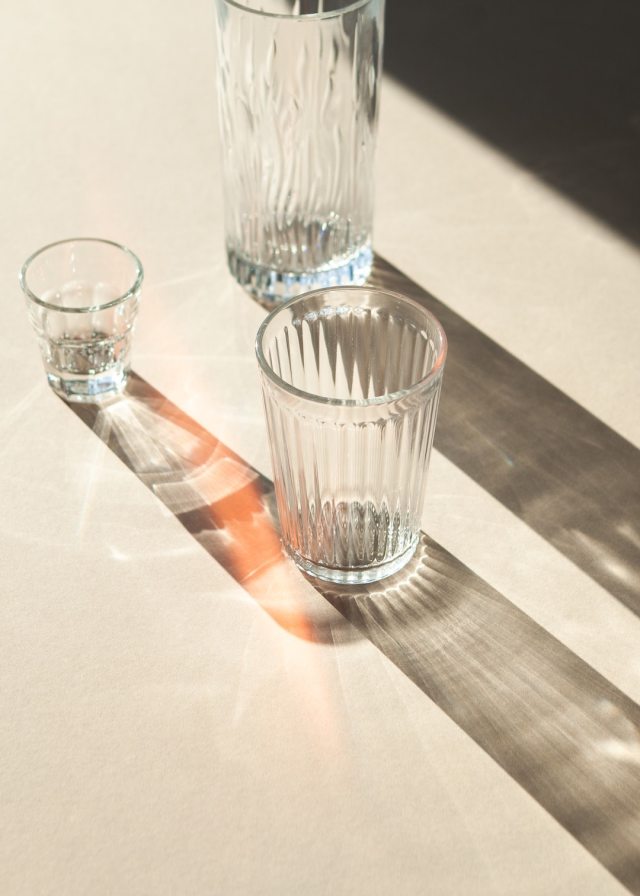
Lesson: Demonstrate the principles of reflection and refraction with this easy experiment . Light bending, aka refraction, takes place as light waves pass through the water. When you shine your flashlight (or position your glass so the sun comes in) you are bending the light waves, each one of the waves at slightly different angles resulting in the different colors of the rainbow. This is the same basic principle that occurs when water and sunlight create a rainbow in the sky. Reflection is the light bouncing off of the mirrored surface.
You will need:
A small mirror (like a compact mirror)
A glass of water (big enough to hold the mirror)
A flashlight (or sunlight)
A piece of white paper or a white wall
1. Put the mirror in the glass of water.
2. Turn off the lights and draw the curtains. Make sure the room is totally dark.
3. Shine the flashlight on the mirror and check out the cool mini-rainbows that appear above the mirror. Put your hand behind the glass for extra fun.
2. The Garden Hose Technique

Lesson: Refraction, as above. This time, instead of using a mirror to reflect the light, you are going to basically mimic the natural formation of a rainbow by causing the water to hit the light in a fine mist.
A spray bottle or a hose
1. Put the hose on mist or grab your mister and spray it into an area of your yard/house/garden that has natural sunlight hitting it.
2. Let the kids ooh and ahh over your rainbow-making skills, then let each of them take a turn.
3. Water Density Rainbow

Lesson: By adding more or less sugar to each water solution you are creating different density levels. When you add coloring to the glasses you will be able to see which solution is the heaviest. Add the colors in rainbow order to impress the kids. Visit Little Bins for Little Hands for the experiment that shows you how to make a rainbow.
Food coloring
Five glasses or plastic cups (clear)
4. The Glass o’ Water Approach
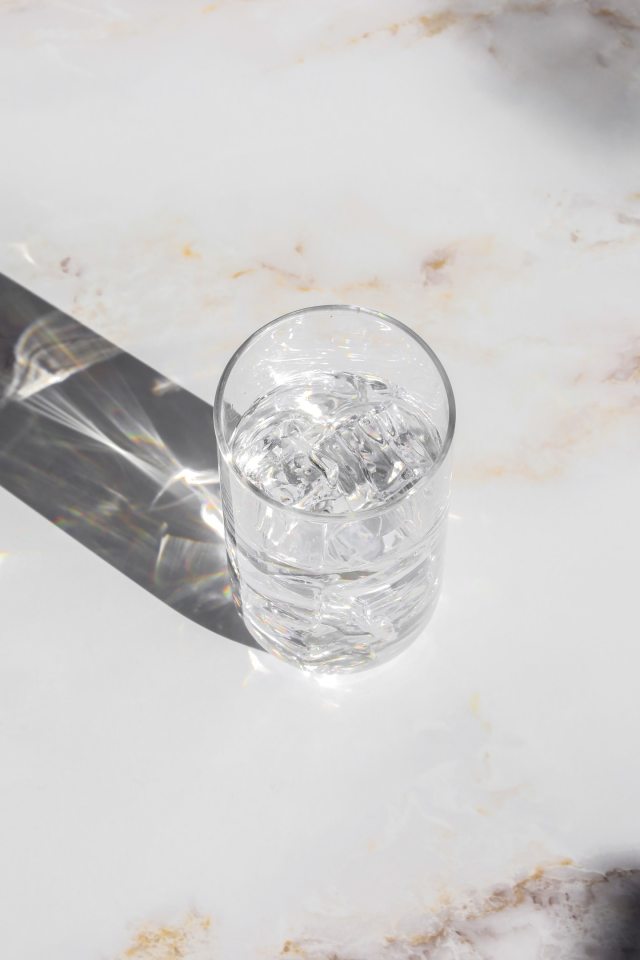
Lesson: The most simple form of light bending, this lesson in the light waves is similar to #1 above.
A glass of water
A piece of paper
1. Put the glass of water in the sunlight.
2. Put the paper next to it.
3. Let the sunlight stream through the water and create a rainbow on the paper.
5. Advanced Glass o’ Water Approach:
A spray bottle
1. Put the glass of water on a table or windowsill where there is sunlight.
2. Put the piece of paper on the floor where the sunlight hits, in the line of the glass.
3. Spray the window with warm water where the sun is coming through, and so it lines up with the paper.
4. Move the glass and paper around until you see a neat little rainbow on the paper.
6. The Bubble Method

It doesn't get any easier than making a rainbow by blowing bubbles. You can use regular dish soap and a bit of water and shake ingredients inside a bottle, or just blow bubbles and observe. Want to up the fun factor? Make your own bubble mixture out of ordinary kitchen ingredients.
Need some fresh ideas?
Subscribe to our weekly newsletter for expert parenting tips and simple solutions that make life instantly better.
By subscribing you agree to Tinybeans Terms and Privacy Policy
Related reads

Why Are Gen Z Kids Covering Their Noses in Family Photos?

Screen Time for Babies Linked to Sensory Differences in Toddlerhood, Study Shows

Kids Shouldn’t Have to Finish Dinner to Get Dessert, Dietitian Explains

The Questions Parents Should Be Asking Their Pediatrician—but Aren’t
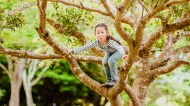
6 Better Phrases to Say Instead of ‘Be Careful’ When Kids Are Taking Risks
- your daily dose

- and connection

- Your daily dose

Get Your ALL ACCESS Shop Pass here →
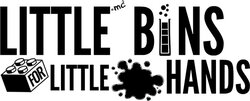
Rainbow Science Experiments
Everything is brighter with rainbows even a rainy day because that’s the perfect time to hope to see one! Whether you are looking for a pot of gold at the end or love the way the colors combine, exploring rainbows through science and STEM activities is a great way to get started! Find a fun selection of simple to set up rainbow science experiments to try out all year long. Any time of the year is perfect for exploring rainbows!

Explore Rainbows
Over the past year, we have explored rainbow and rainbow-themed science experiments. The difference? We have studied how real rainbows form and how light science plays a role in creating rainbows.
However, young kids also just love fun, rainbow-themed science activities that also showcase simple science concepts such as reactions , polymers , liquid density and crystal growing .
Below, we have included both kinds of rainbow science experiments. But before you get into all the fun, read on to learn some rainbow science.
How Rainbows Are Formed
A rainbow is formed when light passes through water droplets in the atmosphere. The water droplets break white sunlight into the seven visible spectrum colors. You can only see a rainbow when the sun is behind you and the rain in front of you.
There are 7 colors in the rainbow: violet, indigo, blue, green, yellow, orange, and red.
Make sure to look out for a rainbow next time it rains! Now, let’s try a rainbow science experiment or two!
Free Printable Rainbow Activities Guide and STEM Cards
Download this free mini Rainbow pack to get started today!
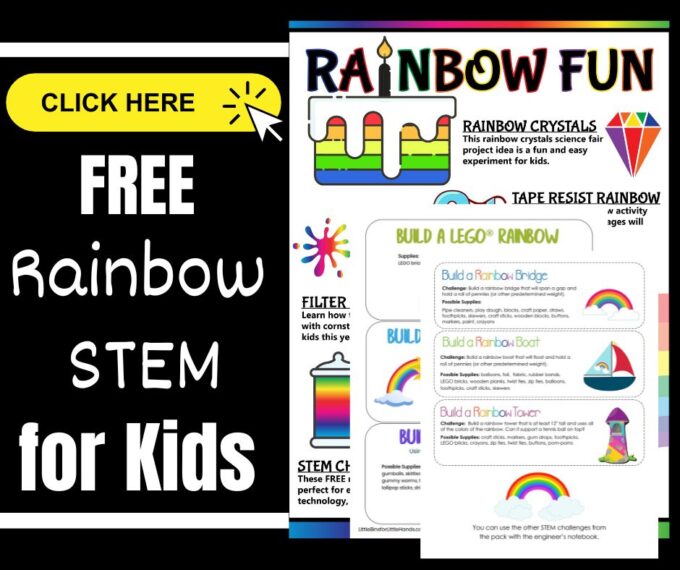
Want to turn a rainbow science experiment into a rainbow science project? Check out our easy science fair project ideas!
1. Make A Rainbow
Grab some prisms, old CDs and more, and explore how visible light can split into the colors of the rainbow.
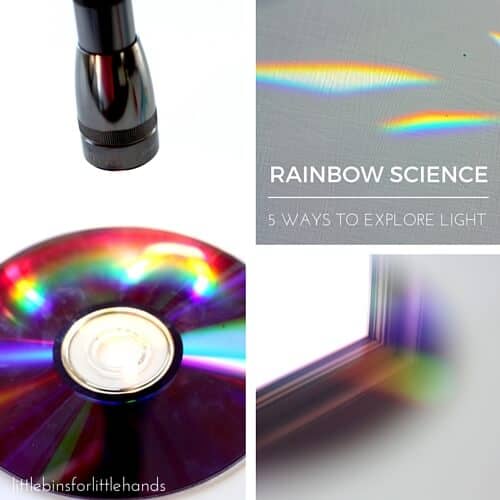
2. Rainbow Crystals
Grow crystals using a classic crystal growing recipe with borax and pipe cleaners. This rainbow science activity really grows awesome crystals that are both sturdy and beautiful to look at. Create a science craft with a pipe cleaner rainbow design!
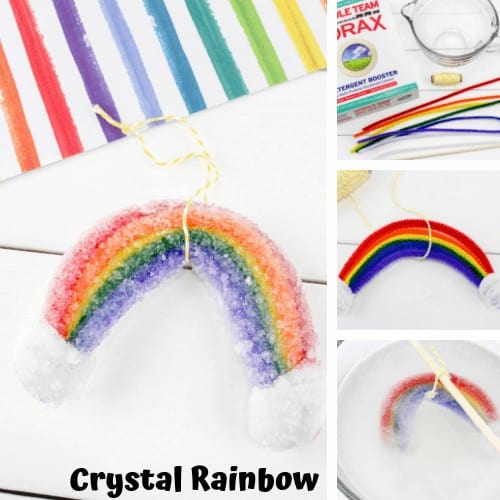
3. Erupting Rainbow Science Experiment
A classic reaction for simple chemistry and a mix of colors to create an erupting rainbow!
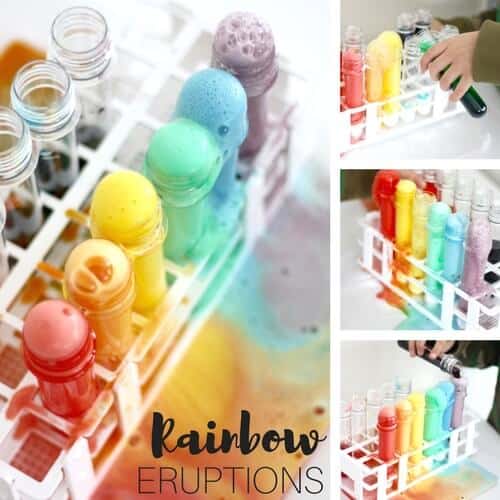
4. Walking Water Rainbow
This walking water experiment is incredibly easy and fun to set up for kids. Watch the water travel as it makes a rainbow of color, and learn about capillary action too!
Here is another way to set it up that’s great for groups of kids, and younger ages! See our grow a rainbow experiment.
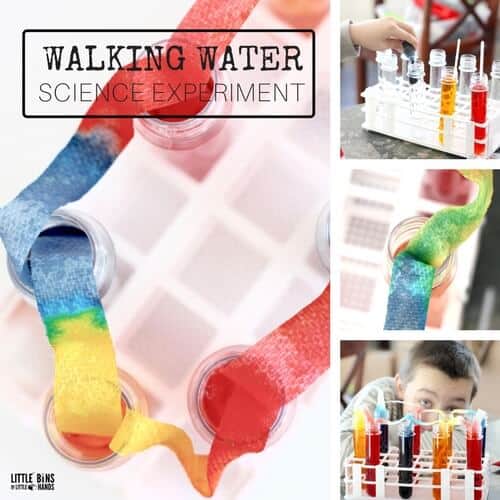
5. Build LEGO Rainbows
Explore symmetry and design with a rainbow LEGO building challenge.
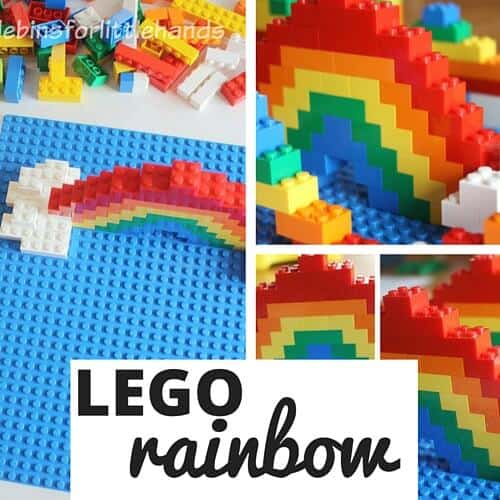

6. Rainbow Density Experiment
Super easy kitchen science using sugar, water, and food coloring. Explore the density of liquids to create a rainbow.
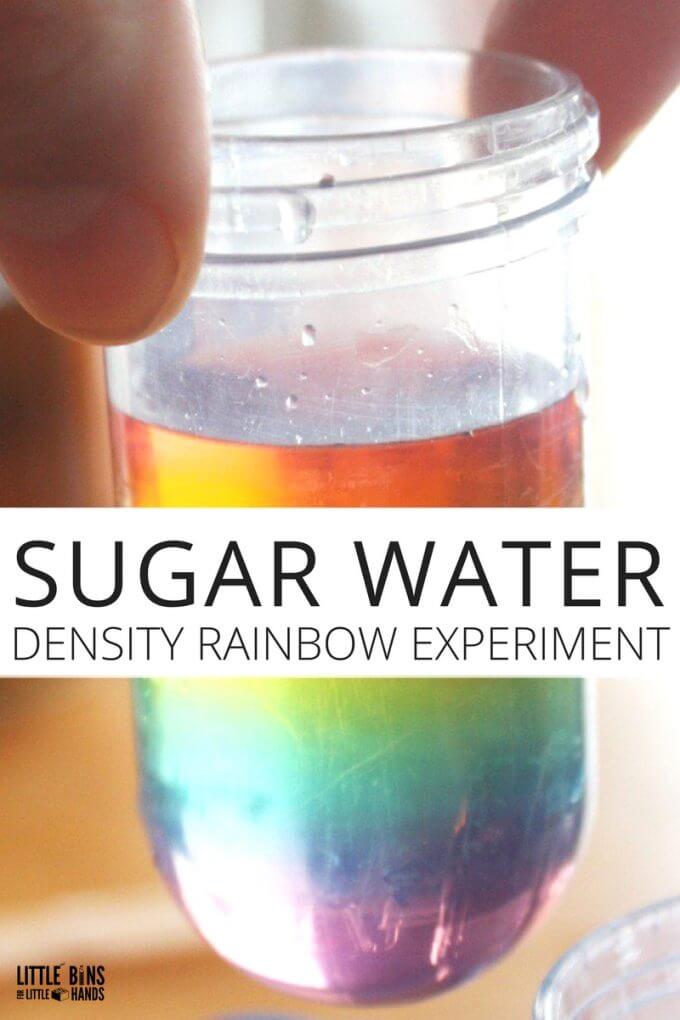
7. Make Rainbow Slime
Learn how to make the easiest slime ever and create a rainbow of colors!
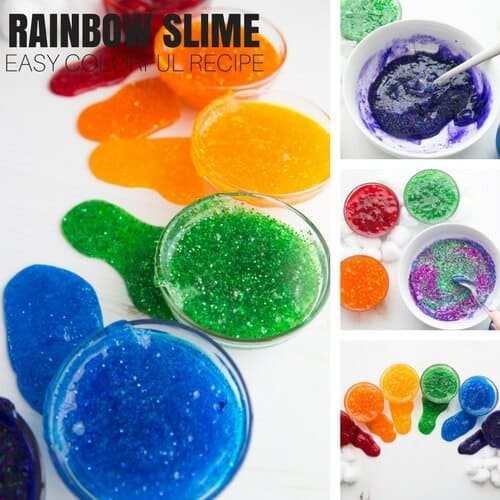
8. Rainbow Fizzing Pots
A leprechaun’s dream with a cool chemical reaction in mini black cauldrons!
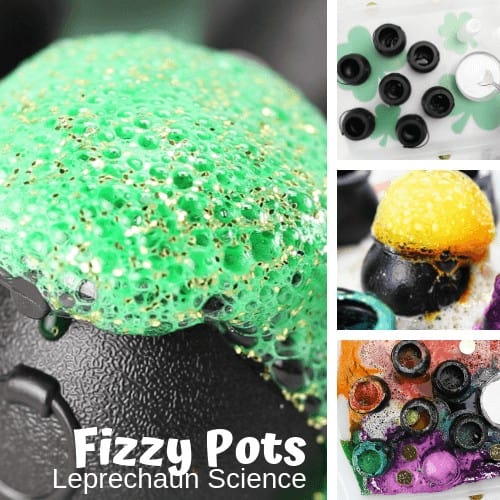
10. Rainbow Oobleck
Oobleck is an awesome science activity for exploring non-Newtonian fluids. Do you know what a non-Newtonian fluid is or how it works? Learn more through this hands-on activity that uses basic kitchen ingredients.
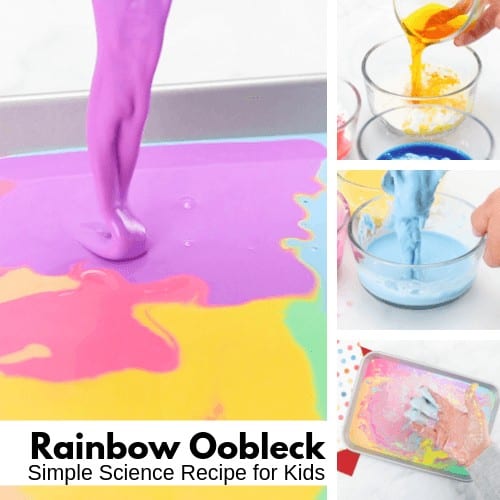
11. Rainbow Solubility
Make this fun rainbow craft with a few simple materials and explore solubility in the process.
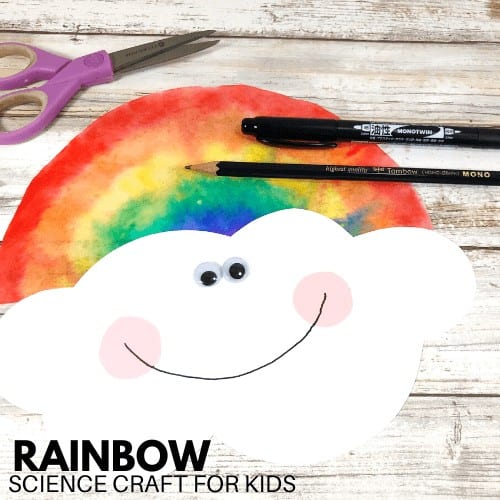
12. Make a Spectroscope
A spectroscope or a spectrograph is a scientific instrument used to study the properties of light. It breaks light down into different wavelengths, called a spectrum. It works similar to how a prism splits white light into a rainbow .
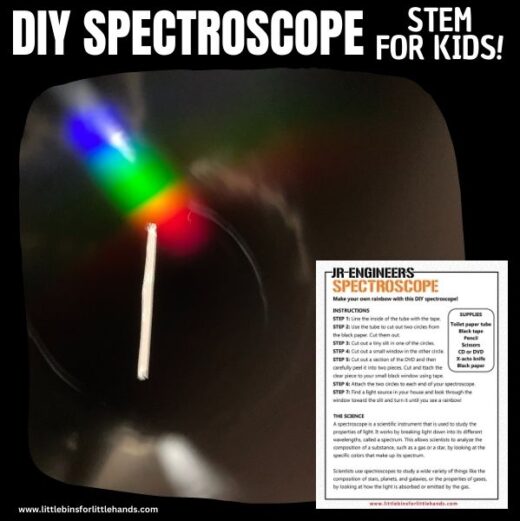
12. Grow a Rainbow
Explore capillary action with markers and paper towels. “ Growing a rainbow ” is a fun science demonstration for various ages!

More Fun Science Topics To Explore
- Baking Soda & Vinegar Experiments
- Simple Machine Projects
- Chemical Reaction Experiments
- Density Experiments
- Water Experiments
- Capillary Action
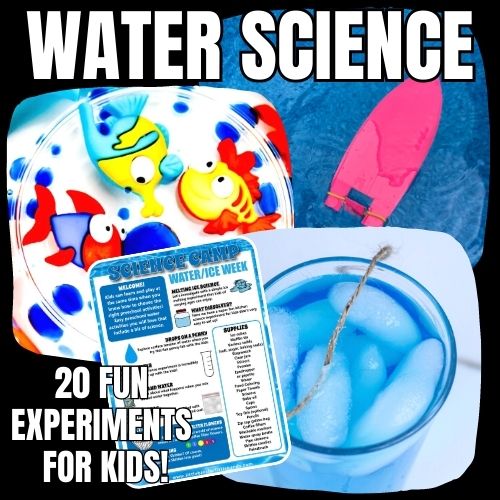
Helpful Science Resources To Get You Started
Here are a few resources that will help you introduce science more effectively to your kiddos or students and feel confident yourself when presenting materials. You’ll find helpful free printables throughout.
- Best Science Practices (as it relates to the scientific method)
- Science Vocabulary
- 8 Science Books for Kids
- All About Scientists
- Free Science Worksheets
- Science Supplies List
- Science Tools for Kids
Printable Science Projects For Kids
If you’re looking to grab all of our printable science projects in one convenient place plus exclusive worksheets and bonuses like a STEAM Project pack, our Science Project Pack is what you need! Over 300+ Pages and 90 projects!
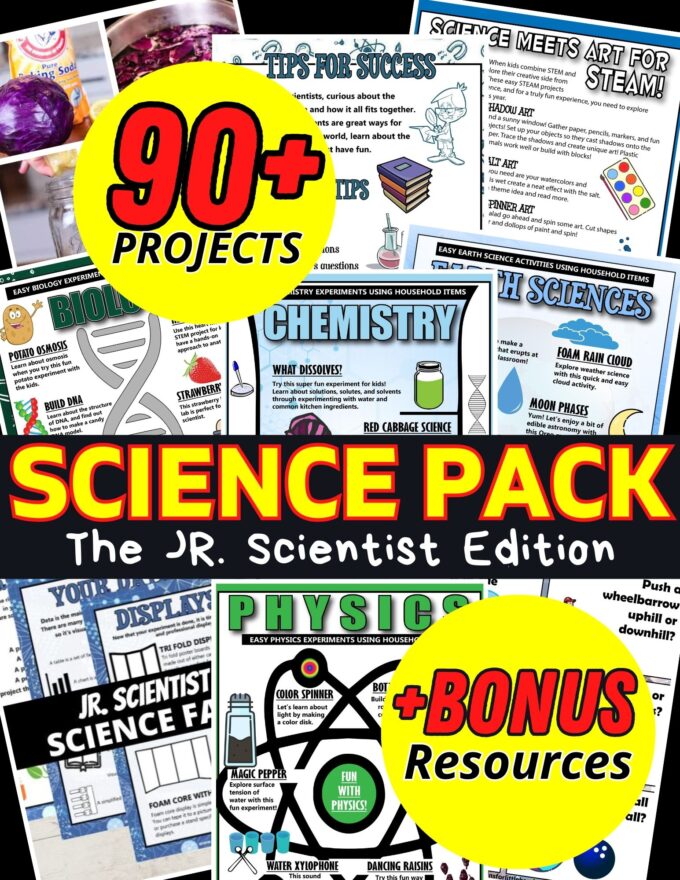
- Pingback: Make Rainbow Slime Recipe for Amazingly Colorful Homemade Slime
- Pingback: St Patricks Day Chemistry Experiments (that are actually easy to set up!)
I love using your projects with my grandson. I am now faced with distance learning for my students. I am a STEM teacher at an elementary school. A lot of your project lend themselves easily to distance learning. What is your position on using some of your projects in my Google Classroom? Please advise. Thank you.
Comments are closed.

Subscribe to receive a free 5-Day STEM Challenge Guide
~ projects to try now ~.
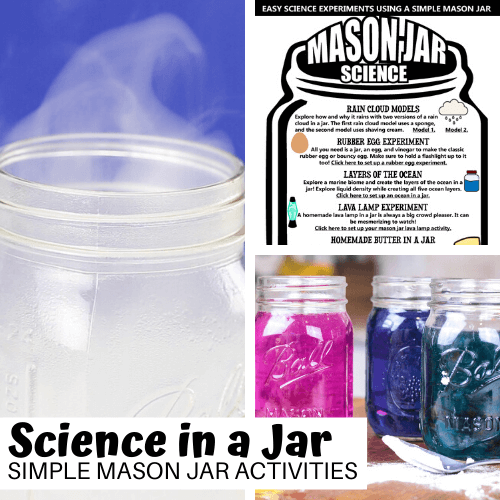
Cool Science Experiments Headquarters
Making Science Fun, Easy to Teach and Exciting to Learn!
Science Experiments
Rainbow in a Jar Science Experiment
Want to make your own rainbow? In this simple science experiment, kids can build their own rainbow in a jar while exploring density, mass, and volume.
Watch our demonstration video, gather your supplies, and print out our detailed instructions to get started. An easy to understand explanation of how it works is included below.
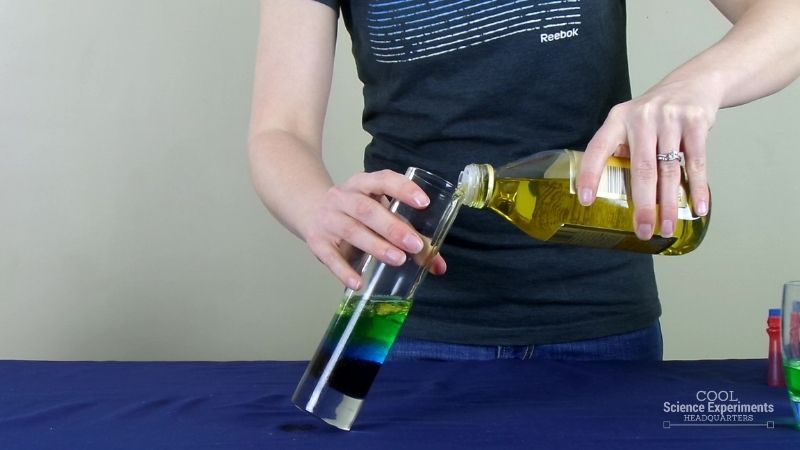
JUMP TO SECTION: Instructions | Video Tutorial | How it Works
Supplies Needed
- Tall Glass Jar
- Food Coloring: Red, Blue and Green
- 1/4 cup Honey
- 1/4 cup Blue Dish Soap
- 1/4 cup Water
- 1/4 cup Olive Oil
- 1/4 cup Rubbing Alcohol
- Jars for mixing and pouring
- Teaspoons for mixing
Rainbow in a Jar Science Lab Kit – Only $5
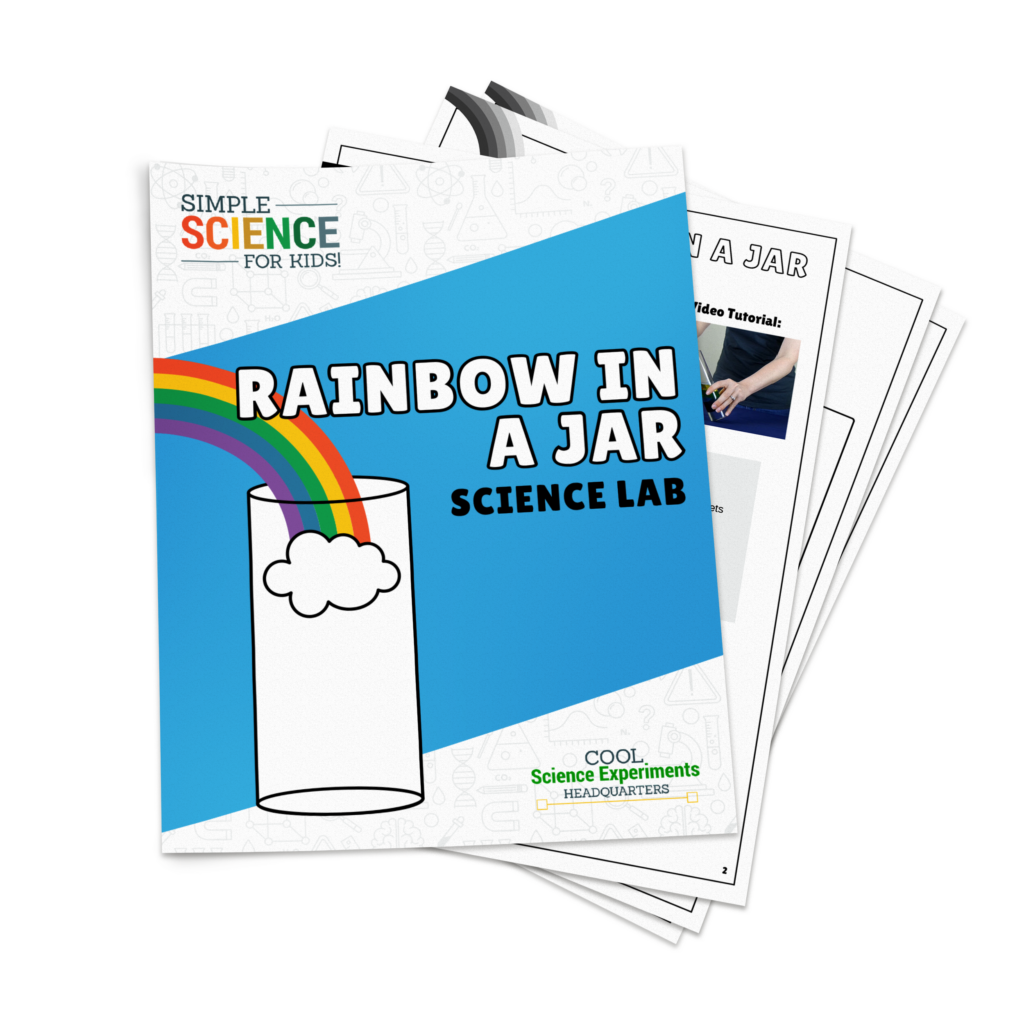
Use our easy Rainbow in a Jar Science Lab Kit to grab your students’ attention without the stress of planning!
It’s everything you need to make science easy for teachers and fun for students — using inexpensive materials you probably already have in your storage closet!
Rainbow in a Jar Science ExperimentInstructions
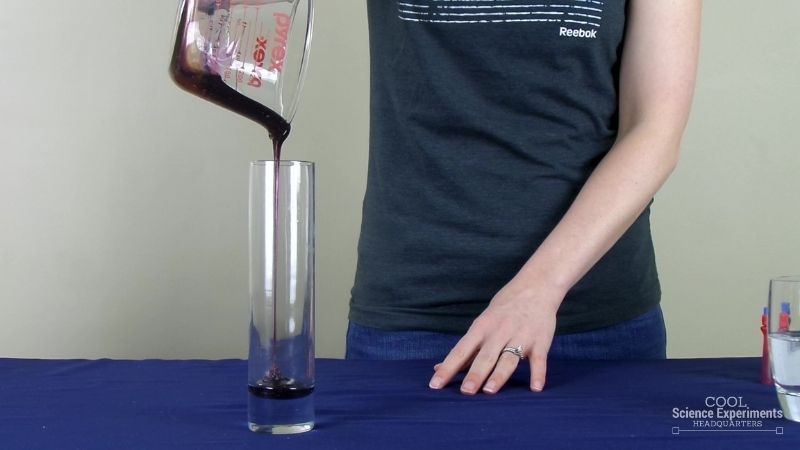
Step 1 – Add one drop of red food coloring and one drop of blue food coloring to 1/4 cup of honey and stir until combined. This creates a purple color liquid. Pour the purple liquid carefully into the tall jar.
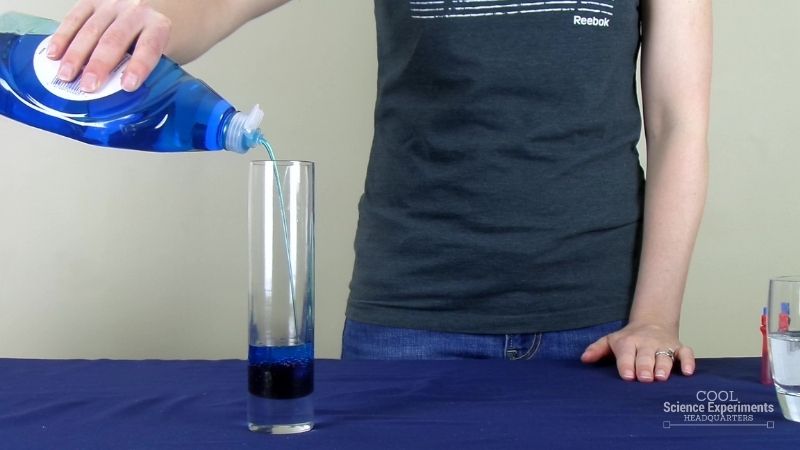
Step 2 – Next add about 1/4 cup of blue dish soap to the tall jar.
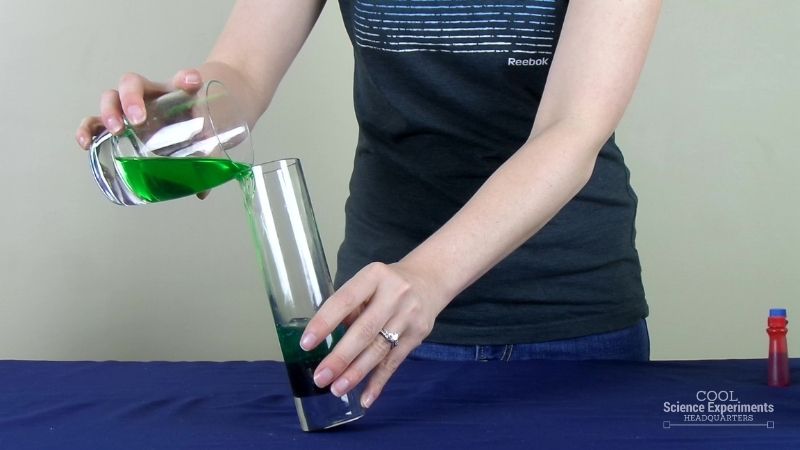
Step 3 – Add a few drops of green food coloring to 1/4 cup of water and mix until combined. Then, carefully pour the green liquid into the tall jar. Tip: When pouring in the green liquid, tilt the jar so the liquid runs down the side of the jar slowly.
Step 4 – Wait a few moments and then slowly pour 1/4 cup of olive oil into the jar. Again, be very careful when pouring in the liquid. Make sure to tilt the jar and pour very slowly so the colors don’t mix.
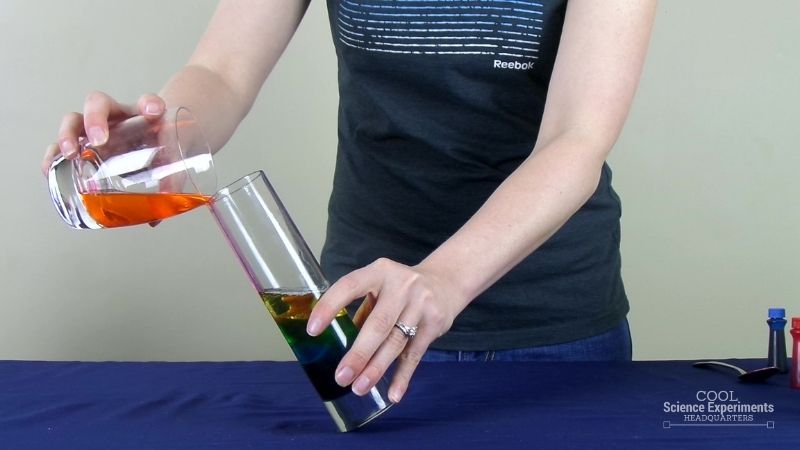
Step 5 – Add a few drops of red food coloring to 1/4 cup of rubbing alcohol and mix until combined. Then, carefully pour the red liquid into the tall jar. Tip: I can’t stress enough how important it is to tilt the jar and pour slow. Otherwise, the colors will mix together and you won’t get a distinct rainbow.
Do you know why you were able to make the liquids form the rainbow in a jar? Find out the answer in the how does this experiment work section below.
Video Tutorial
How Does the Science Experiment Work
Density is the reason that this experiment works! Density is a measure of how much mass (or “stuff”) there is in a given volume. Density is a ratio of mass to volume and can be found by dividing an object’s mass by its volume (D=m/v).
Based on this equation, if the mass of something increases but the volume stays constant, then the density increases. Also, if mass decreases but the volume stays constant, then the density decreases. Density is all about how tightly packed the matter making up the material is in a given volume. Lighter liquids (like olive oil and rubbing alcohol) are less dense than heavier liquids (like honey and dish soap) because they have less matter in a given volume. Because olive oil and rubbing alcohol are less dense, they will float on top of liquids like water, dish soap, and honey. Liquids with a lower density will always float on top of liquids with a higher density.
All liquids have their own unique density. Water has a density of 1 g/mL (g/cm3). Objects will float in water if their density is less than 1 g/mL. Objects will sink in water if their density is greater than 1 g/mL.
I hope you enjoyed the experiment. Here are some printable instructions:
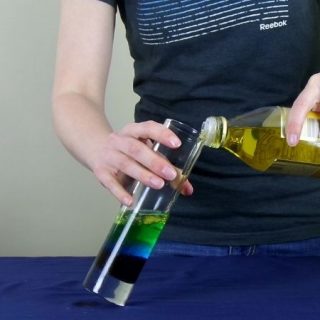
Instructions
- Add one drop of red food coloring and one drop of blue food coloring to 1/4 cup of honey and stir until combined. This is create a purple color liquid. Pour the purple liquid carefully into the tall jar.
- Next add about 1/4 cup of blue dish soap to the tall jar.
- Then add a few drops of green food coloring to 1/4 cup of water and mix until combined. Then carefully pour the green liquid into the tall jar. Tip: When pouring in the green liquid, tilt the jar so the liquid runs down the side of the jar slowly.
- Wait a few moments and then slowly pour 1/4 cup of olive oil into the jar. Tip: Again, be very careful when pouring in the liquid. Make sure to tilt the jar and pour very slowly so the colors don’t mix.
- Add a few drops of red food coloring to 1/4 cup of rubbing alcohol and mix until combined. Then carefully pour the red liquid into the tall jar. Tip: I can’t stress enough how important it is to tilt the jar and pour slow. Otherwise the colors will mix together and you won’t get a distinct rainbow.

Reader Interactions
October 15, 2017 at 3:22 pm
It was cool. Was it density
October 30, 2017 at 11:33 am
Hi it was Cooooolllllll….. It was because of the density
June 12, 2018 at 10:22 am
my kids enjoyed this presentation. They are doing it for a stem project
March 25, 2019 at 3:41 pm
How long did this project take to make and how long did it last until the colors started to mix? Also, what would be the guiding question of an experiment like this?
March 2, 2023 at 11:46 am
1.This experiment took around 20 minutes to put together. 2. It lasts for as long as you need if nobody touches it. 3. A leading question to this experiment could be ” Will all of the ingredients mix while i am pouring?”
I hope this helped:)
January 23, 2020 at 12:41 pm
its amazing my students loved it!
March 2, 2023 at 11:40 am
I did this exact project for the science fair this year and I won 2nd place. I made a full board about destiny and I made a question saying ” If I do not tip the jar or if i pour too fast, will the colors mix? The answer is yes! The colors did mix whenever I didn’t tip the jar and the rubbing alcohol sank down and mixed with the green and then since the extra liquid was in the green it mixed with the blue dish soap and began to be a big bubbly mess! 🙂
June 12, 2023 at 10:15 am
Can you put a top on the jar, shake the jar, mixing the liquids, will the liquids separate after sitting for hours or days?
Leave a Reply Cancel reply
Your email address will not be published. Required fields are marked *
Save my name, email, and website in this browser for the next time I comment.

- Privacy Policy
- Disclosure Policy
Copyright © 2024 · Cool Science Experiments HQ

Simple Rainbow Science Experiment for Kids
- Rainbows Science St. Patrick's Day
Spring is here and you and your students will love this Simple Rainbow Science Experiment for Kids that is quick and fun to do! This would be a great experiment to try around St. Patrick’s Day or perhaps while studying a weather unit. Students may want to draw or color their rainbows in a science notebook as well. We love doing science experiments in my classroom and this easy rainbow experiment proves that they don’t have to be complicated or hard to prep for!
*Pair with our St. Patrick’s Day Centers and Activities for Pre-K & Kindergarten !

Bring some hands-on science fun to your classroom with this easy, no-mess experiment! You can do this science experiment in the springtime or any time of the year!
Teach your early learners all about reflection, refraction, and dispersion of light!
To make your own rainbow, you will need:
- a glass of water
- a sunny window
- a sheet of white paper
How to Make a Rainbow
To begin, invite your child to place a glass of water near a sunny window. For best results, look for a direct beam of sunlight. When the sun is low in the sky (early or later in the day) works best.
Next, place a sheet of paper on the other side of the glass. You should notice a rainbow that is projected onto the sheet of paper!

RELATED RESOURCE: Easy Readers – Color Words Collection
Here’s how it works.
Sunlight is made up of various wavelengths, and each wavelength appears as a different color. The water is used to reflect and refract light. As the sunlight passes through the water, the sunlight is separated into a spectrum of colors forming a rainbow.

Questions to Consider:
- Can you think of another way to make your own rainbow?
- What happens if you change the shape or size of the glass of water?
- What happens if you place the paper further away from the glass?
- Add a few drops of food coloring to the water. Are you still able to make a rainbow?
- Replace the water with mineral oil . What happens?
- If there were no signs of rain, would you be able to see a rainbow outside? Why or why not?
- Draw and color your observations in a notebook .
Want unlimited access to even MORE of our activities and resources? Join us in the Print and Play Club!
Your planning will be so much easier with instant access to:
- hundreds of printables
- every TKC resource
- video lessons
- a digital games vault
- Pre-K, TK, and Kindergarten Scope & Sequence
- a PLAYlist of fun songs AND activities
- professional development
- additional teacher resources…

Be sure to request an invitation so that you don’t miss your chance to be part of the best early childhood club around!

One Response
So simple but so amazing. Thank you!
Leave a Reply Cancel reply
Your email address will not be published. Required fields are marked *

- Search Search

thekindergartenconnection
🖍️ Resources for Pre-K, TK, and Kindergarten teachers in the best early childhood club around! ⭐️ Request an Invitation ⬇️
© 2024 THE KINDERGARTEN CONNECTION
- X (Twitter)

10 Exciting Rainbow Science Experiments
Any affiliate links in this post will be clearly marked with a * and if you click a link and buy a product, then I may receive a small commission at no extra cost to you. Thank you for supporting my blog!
Giving children varied opportunities to learn is so important. With the twiglets I often end up just doing crafty-type activities with them at home, and not much else. (Well apart from the obvious screen time, reading, free play etc!) But I also really want to inspire a love of science in them too. After all, it does explain basically everything that’s going on around us! And you know with us it’s allll about the rainbows! So I’ve pulled together some of the best and most exciting rainbow science experiments for kids .
Erupting rainbow science experiment

Can you make a rainbow volcano?
Love this erupting rainbow science experiment from Little Bins For Little Hands.
Rainbow walking water experiment

Can you create a rainbow with food colouring and water?
This rainbow walking water experiment from Fun Learning For Kids is so awesome! Word of warning though – I tried this with my Reception class and could not get it to work! So my advice would be make sure you have the right type of kitchen towel!!
Growing rainbow crystals experiment

Can you make a rainbow out of crystals?
Growing your own rainbow crystals looks like such a fun activity for kids! From Little Bins For Little Hands.
Rainbow Skittles experiment

Can you make a rainbow by adding warm water to Skittles?
Why not give the famous rainbow Skittles experiment a try? You can find the method in lots of places – this version is from Mas And Pas 🙂
Rainbow ice and salt experiment

What happens when salt and food colouring are added to ice?
This rainbow ice and salt experiment from Powerful Mothering looks fab, especially for younger children and preschoolers.
Rainbow water xylophone

What happens when you hit bottles with different amounts of water in?
I love this rainbow water xylophone experiment from Mama Papa Bubba.
Climbing rainbow science experiment

What happens when you put rainbow marker pen on kitchen towel then put it in water?
How beautiful does this climbing rainbow idea from Coffee Cups And Crayons look?
Rainbow baking soda experiment

What happens when you add vinegar to baking soda?
This rainbow baking soda experiment from Messy Little Monster looks like loads of fun 🙂
Fizzing scented rainbow science experiment

This fizzing scented rainbow science experiment from Fun A Day looks amazing! Same concept as the previous baking soda experiment but with more of a sensory focus 🙂
More rainbow sensory activities here 🙂
Rainbow in a jar experiment

What happens to the density of water when you add sugar?
Kids would love this rainbow in a jar experiment from Primary Playground.
Have you tried any of these rainbow science experiments before?
And if you fancy making things a bit easier for yourself, there are some fab kits out there to guide you and provide what you need for creating some rainbow science!
* affiliate links

Thanks for reading! Til next time,
Looking for rainbow craft ideas ?
Like it? Pin it!

Check out these posts:
- STEM toys from Learning Resources
- Fun EYFS space activities

Related Posts
20 amazing rainbow sensory play ideas, 10 fun and exciting obstacle course ideas for kids, 15 easy spring craft ideas.
Rainbows are just the best! We’ve tried a few of these experiments and the boys loved them. 🙂 x
Aw fab 🙂 xx
These are all fab ideas! We’ve tried the climbing rainbow one, and my three are constantly asking to try the Skittles one! Truthfully, I can’t bare to buy something so tasty and not eat it though! Haha
Haha Skittles are very yummy, I wasn’t allowed to eat them as a kid because all the colourings were so bad for my eczema haha!
I think the rainbow jar is my favourite! #kcacols xx
These are great!! Colourful adds to the fun too! #KCACOLS
My daughter would love all of these! I particularly like the rainbow crystals 🙂 #KCACOLS
My boys have done the rainbow skittle experiment and blew their kinds lol x #kcacols
I love the rainbow in a jar and the skittles experiment. Iris is just starting to get into science so she’d love these.
Katrina x #KCACOLS
Please leave a comment - I'd love to hear from you! Cancel reply
This site uses Akismet to reduce spam. Learn how your comment data is processed .

- Work With Me
Privacy Overview
Privacy Policy
Awesome Rainbow Science Experiments for Kids
Rainbows are so much fun! They are even more fun to experiment with! That’s why I’ve gathered up some must-try awesome rainbow science experiments for kids!

Whether its mixing colors, making colors, or just using colors to demonstrate an idea, rainbows make science a whole lot more colorful!
10 Awesome Rainbow Science Experiments for Kids
Rainbow Reactions are a great way to explore chemical changes and test hypothesis!
Test and learn about density with this Rainbow in a Jar .
These rainbow eruptions are perfect for any age!
This might be one of the simplest demonstrations of how to make a rainbow , but still so awesome!
I have always been fascinated by this experiment using rainbows to feed ants . You have to check it out!
Have you seen these rainbow crystals ? So cool I had to include the video for it!
Want to experiment with color mixing, try setting up a simple color laboratory !
Let your kids experiment with chromatography with this simple rainbow filter !
Have you ever made crystals? What about an entire crystal rainbow ?
Get your toddler involved with this simple rainbow and milk experiment !

For more rainbow fun, be sure to check out these awesome Rainbow Learning Activity and Snacks over at Melissa & Doug!

Do you have a favorite rainbow experiment? I would love to hear all about it! You can share them on Facebook , Twitter , Google+ , Pinterest , Instagram or subscribe by email in the sidebar.
More Adventures in Science

FREE DOWNLOAD
Discover how to get siblings to get along even when all they do is annoy each other with the Sibling “Get Along” Poster Pack!
7 thoughts on “Awesome Rainbow Science Experiments for Kids”
Pingback: Lego Inspired Electric Play Dough - Lemon Lime Adventures
These are amazing
Pingback: Top 10 Color Theory Experiments for Kids - Lemon Lime Adventures
Pingback: Rainbow Activities & Snacks for Kids! • Melissa & Doug Blog
Pingback: Exploring Vegetable Seeds | Simple Science for Toddlers - Lemon Lime Adventures
Can I just use lemon juice for the rainbow eruptions rather than lemon juice and citric acid?
Pingback: Awesome Rainbow Science Experiments for Kids – Science Time
Leave a Comment Cancel Reply
Your email address will not be published. Required fields are marked *
Save my name, email, and website in this browser for the next time I comment.

CONNECT WITH ME
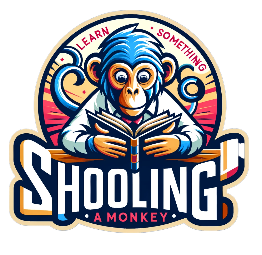
Rainbow science experiments
Key points i covered in this post, what are the best methods for conducting rainbow science experiments, the science of rainbow formation, materials needed for creating a rainbow, step-by-step experiments, understanding light and color spectrum, applications of rainbow experiments in education, safety precautions for conducting experiments, what are some tips for conducting successful rainbow experiments.
- Maximize the light source to produce a more vivid rainbow, by using either direct sunlight or a high-intensity lamp.
- Adjust the angle of light entry when using prisms or water to change the display of the rainbow.
- Experiment with different types of surfaces to catch the rainbow for varied results, such as white paper, walls, or sidewalks.
- Try adding a few drops of milk to the water to enhance the visibility of the colors.
- Consider recording the experiments to analyze the results and observe subtle differences.
How can we create a rainbow in a classroom setting?
What materials are needed for a rainbow science experiment, is it safe for children to perform rainbow science experiments, what scientific principles can be learned from rainbow science experiments, can rainbow science experiments be tied into larger lessons on weather or optics, final thoughts, share article:, quick stem activities, rainbow slime.

IMAGES
VIDEO
COMMENTS
Making a rainbow is a fun and educational science experiment that can be easily done at home or in the classroom. It involves using a light source, such as sunlight or a flashlight, and a medium to separate the light into its component colors.
Use these questions with students to prompt conversation and reflection about the science behind these Rainbow STEM activities: How is a rainbow created in the sky? What happens to light to make a rainbow? What science concepts explain the colorful patterns created in the featured activities?
Incorporating rainbows in science activities is not only fun but super easy. These Rainbow Science activities are perfect for the classroom or at home. Most of them don’t require much prep but all of them will have kids smiling in science giddiness! Finally a rainbow discovery bottle that the colors don’t run together!
No rainbow in the sky today? No problem. Just pick one (or all) of these easy kid-friendly science experiments with your rainbow-making know-how. From reflection (mirror) to refraction (water glass) to learning about density, we’ve found six science experiments to make or learn from the rainbow.
Make rainbows and explore rainbow science experiments this year! Create rainbows with slime, crystals, eruptions, and more!
Want to make your own rainbow? In this simple science experiment, kids can build their own rainbow in a jar while exploring density, mass, and volume. Watch our demonstration video, gather your supplies, and print out our detailed instructions to get started.
You can do this science experiment in the springtime or any time of the year! Teach your early learners all about reflection, refraction, and dispersion of light! To make your own rainbow, you will need: a glass of water; a sunny window; a sheet of white paper; How to Make a Rainbow. To begin, invite your child to place a glass of water near a ...
So I’ve pulled together some of the best and most exciting rainbow science experiments for kids. Can you make a rainbow volcano? Love this erupting rainbow science experiment from Little Bins For Little Hands. Can you create a rainbow with food colouring and water? This rainbow walking water experiment from Fun Learning For Kids is so awesome!
Rainbows are so much fun! They are even more fun to experiment with! That’s why I’ve gathered up some must-try awesome rainbow science experiments for kids! Whether its mixing colors, making colors, or just using colors to demonstrate an idea, rainbows make science a whole lot more colorful!
Rainbow science experiments are a fun and educational way for children and students to learn about the science of light, color, and optics. These experiments can demonstrate how light bends or refracts when it passes through different mediums, leading to the dispersion of white light into the colors of the spectrum. 2.